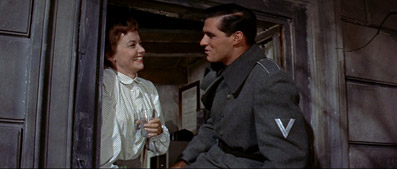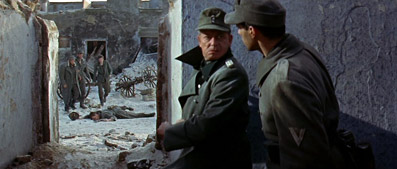|
To think of Douglas Sirk is to think of American suburbia, extreme emotions and Rock Hudson. Much has been written about Imitation of Life, Written on the Wind, All That Heaven Allows and Tarnished Angels: sniffily dismissed as low, effeminate melodramas by contemporary critics, they were reclaimed by a later generation as sly attacks on American culture that elevated Sirk to auteur status. He was championed as a master of visual metaphor and irony, who celebrated the sumptuousness of domesticity whilst simultaneously using it to entrap his characters. In this film, Sirk's melodramatic visual style is fused with EM Remarque's nihilistic war story to create something more surreal and affecting.
John Gavin plays Ernst Graeber, a German soldier fighting on the Eastern front in 1944. As his regiment retreats from the advancing Russian forces, he is unexpectedly granted furlough and 3 weeks leave. Returning home to a shattered Hamburg, he begins a slow, futile search for his parents. He meets Elizabeth (Liselotte Pulver), daughter of his family physician and the two begin a romance. As Ernst's three weeks draw to a close, the two attempt to come to terms with Ernst's inevitable return to the front, as well as a Gestapo summons for Elizabeth...

Although it runs for over 2 hours, not a great deal actually happens in the film. It is structured in a highly episodic way – threats or complications arise, are dealt with and resolved, then another complication occurs. For example, at one point Ernst and Elizabeth go to the registrar's office to see if it is possible for them to get married. Due to Elizabeth's father being regarded as a traitor by the Reich, Ernst is worried that Elizabeth will be in danger when the official checks her papers. He has her wait in a corridor in case of complications, arranging to signal her if anything goes wrong. The signal is mistakenly given, and Elizabeth flees. This could be expected to continue as an important plot strand throughout the rest of the film, but it isn't: Ernst simply catches up with Elizabeth and the confusion is cleared up. The constant cycle of threat and escape leaves the story occasionally feeling slightly baggy and wandering, not entirely sure of its own direction, and as such there is no sense of climax. The final scene features some very touching imagery, and ends on a poignant, downbeat note; in plot terms however, it is just another cycle of threat and resolution, taking away some of the emotional impact that this scene should have.
In a way, the lack of a well-structured plot is a minor quibble, as the attraction of A Time to Love isn't in its story, it's in the fusion of the melodramatic with the nihilistic. The film is full of grimly beautiful imagery. Early on in the film Ernst's regiment makes its way through a frozen village, and discover a withered hand reaching out from beneath the snow. An argument occurs about whether or not the dead soldier the hand belongs to is a casualty of the November or January campaign that is almost blackly humorous. As the soldiers dig him out, a young private remarks that the corpse appears to be crying, to which Ernest responds 'His eyeballs were frozen. They're thawing now.' This kind of darkness pervades the film, particularly in these early moments with the frontline troops, who are represented as wearily cynical of the ongoing campaign. When ordered to execute captured guerillas, one solider says he will shoot over the prisoners' heads so as not to be the one who kills them – Ernst again remarks that there would be no point as they would merely be commanded to reload and shoot again. Once Ernst returns home, all the characters he encounters are war-damaged: a soldier with gout who drinks to stay in hospital; a woman who thinks everyone who remains outside the bomb shelter during the raids must be dead; an old man who memorizes the desperate messages fleeing citizens left behind for their loved ones on the community notice board. Everyone is coloured by their experience of war, and there is a pre-occupation with the details of daily life in wartime: one old woman tells the couple that she pretends to the government that her daughter is still alive in order to keep her bedroom the way she left it, and one of Ernst's old school mates laughs about how he had his old history teacher put in a concentration camp as revenge for marking down his exams. This war-fatigue threatens to intrude on the few moments that look like genuine melodramatic excess: witness a scene in which Ernst dons a borrowed dress uniform and takes Elizabeth to a high-class restaurant, only to end up fleeing in terror when an allied bomb hits it. Similarly when Ernst and Elizabeth are planning their honeymoon, they realize they cannot go anywhere due to the reach of the German war machine and the animosity they will encounter in places like Paris and Amsterdam. It's a strategy that's very effective – just as the war impinges on the relationships and lives of the characters, so it does on out enjoyment of the Sirkian melodrama.

The visual layout of A Time to Love and a Time to Die is much like Sirk's previous melodramas. Shards of light slice through frames, wrenching the characters away from each other; scenes are colour-coded to the emotions of the characters and tone of the world (here, mainly dull grey, brown and white); small camera movements track and nag the characters. Its emotive, heightened, passionate – the score swells and climaxes, the cinemascope photography is brilliantly vivid; the frames are filled with material detail. Its part of what makes Sirk's films so seductive – they are beautiful to look at, almost distractingly so. What is particularly interesting – and impressive – about this film is the way this aesthetic plan is mapped onto wartime Germany. Costumes and props look authentically worn, the characters are all suitably bedraggled (with the exception of the star couple). There is a lot of location shooting, amongst bombed out buildings and piles of rubble and muddy battlefields, but Sirk still manages to maintain his highly composed, painterly look. The emotional desolation of the characters bleeds into the landscape, and vice versa: the realism of those bombsites is harnessed into the melodramatic project.
Unfortunately, some factors prevent this play between fatalism and melodramatic excess from being totally cohesive. John Gavin is eager and handsome but makes for a dull leading man, and Liselotte Pulver's character is a touch irritating. A supporting cast that includes Keenan Wynn, EM Remarque himself and a small role for Klaus Kinski is pretty solid, but there is a worrying split between the 'good' Germans who sport American accents and the 'bad' Germans who speak with native accents. Some of the characters likewise border on caricature: Thayer David as Binding and Kurt Meisel as concentration camp sadist Heini are a bit too much. For the most part however the film succeeds. It is a curious, imaginative film that blends the horrific and the excessive to surprisingly good effect, and can easily be mentioned in the same breath as Sirk's more canonical films.
A handsome 2.35:1 anamorphic transfer that only betrays the film's age through the occasional slight softness on portions of some of the scope imagery (a common problem with early anamorphic lenses) and a colour scheme that feels a little muted and biased towards browns and greys, although the green of window shutters and officers' uniforms is surprisingly vibrant. The contrast is consistently good and the shadow detail and black levels just right. Film grain is more visible in some shots than others, but dust spots are very rare.

The English mono soundtrack is commendably clean for a film of this age, if a little fluffy on the trebles, in contrast to the also included French mono dub, which has a strong treble bias and more background hiss. Both are perfectly serviceable, though, and dialogue and music are clear and free of distortion.
Best of the bunch is Imitation of Life [Mirage of Life]: A Portrait of Douglas Sirk (49 minutes), a filmed interview with Sirk and his wife Hilda that covers many topics; Sirk's visual style, the way is films are constructed, the couple's flight from Germany etc. There are a lot of insights to be gained from the interview, though the slightly stilted style and murky photography make it a little trying on the eyes. A Time to Love is only mentioned once, unfortunately.
Of Tears and Speed is a 12 minute recitation of Jean Luc Godard's essay on A Time to Love, a copy of which is supplied with the booklet that accompanies the film. The visual references help with viewers unfamiliar with the great many literary and cinematic references Godard drops in., and the photographs and handwritten notes that accompany the voiceover look great. The reading is in French, so for those who don't speak the language trying to read subtitles at the same time as keeping up with the visuals can be tricky. Surely an English-language reading could have been provided as well?
Out There in the Dark (19 minutes) has the most tenuous link to A Time to Love, and feels like filler: Cape Fear scribe Wesley Strick wittering on about the novel he wrote about Sirk and indulging in some self-congratulatory name-dropping. He does provide some good biographical details on Sirk though; Sirk watched German propaganda films in order to see his Son, who was a star of the Hitler Youth, and on whose life A Time to Love is apparently based.
The Original Theatrical Trailer (2:41) – always a welcome addition – takes the bulk of its material from the more melodramatic and spectacle moments in the film.
Also supplied with the disc is a brilliant 36 page booklet that includes Godard's essay as well as a very insightful piece by Tag Gallagher on Sirk and Melodrama. There is also a scrapbook of cuttings from other writings on Sirk, including some textual analysis, observations on Sirk's change of name, move to American and the film's title. In addition there are production stills, credits, and the poem Selige Sehnsucht (Blissful Longing) by Johann Wolfgang Von Goethe, a favourite of Sirk's. Finally, there is a page on how to correctly view the 2:35:1 ratio on your TV (black borders top and bottom) – anything else is a 'distortion and corruption of the original artwork, which travesty the integrity of both the human form and cinematographic space'. That's you told.
A very fine film that makes for a touching, affecting if slightly disjointed experience, this will appeal to Sirk devotes and newcomers alike. The disc presented here is very handsomely presented, though the extras are of mixed quality.
|